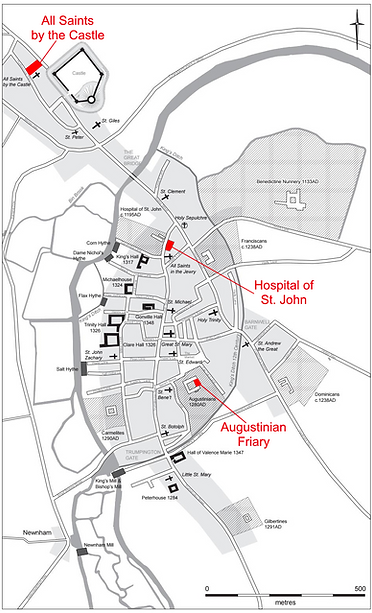
Health and History in Medieval England
Medieval Cambridge
The story of medieval Cambridge spans around 800 years. It tells how a relatively typical county centre and market town slowly developed into a specialized educational centre. In comparison to most medieval English towns, Cambridge was a relatively stable place, marked by the gradual rise of the university that eventually came to dominate the local economy.
Medieval Cambridge developed at a bend in the river Cam where it could easily be crossed. Although there was a settlement in Roman times, it was in the eighth century that the medieval town began to develop. Things took off in the mid/late tenth century. By the time of the Norman Conquest, Cambridge was the main town of the county with 1200-2000 inhabitants. The town served as an administrative centre with a castle, acted as a market place for the local agricultural area and was heavily involved in trade. River boats carried goods, especially grain, down the river to be loaded on to North Sea ships at Lynn. Imports of many kinds came back up the river. Cambridge also lay at the junction of a rich agricultural hinterland to the south and the Fens to the north. The Fens, still undrained at that time, were vast swamps only farmed in small islands but a rich source of fish, game, meadows and marsh resources.
The town continued to grow. From the twelfth century onwards, it attracted a number of religious institutions, including a priory, a nunnery and two hospitals. The University of Cambridge was supposedly founded in 1208-10, although the significance of this date is disputed. The University at this time was small, and although there is evidence of a significant academic community from the 1220s, the first college, Peterhouse, was only formed in 1284.

Cambridge and other sites studied. Dark grey areas are undrained fenlands. Map: Vicki Herring

The town continued to grow throughout the 1200s and early 1300s. Population figures are approximate, but the population may have reached 4000-6000 by around the mid-fourteenth century, before the Black Death struck. The University contributed to this increase, with many scholars living in hostels and about half a dozen new colleges founded in this period. There was also substantial growth in religious establishments: by the fourteenth century, almost every major religious order had a monastery or friary in Cambridge, and some of these were regional study centres for scholars of their order.
In 1348-9, the bubonic plague (Yersinia pestis) epidemic later called the Black Death struck Cambridge. It was catastrophic: as elsewhere in England, it killed between 40 and 60 percent of the population. Most of the dead were buried in ordinary parish cemeteries such as All Saints by the Castle. Some were buried in plague pits such as on Bene't St. Periodic plague epidemics continued every 10-15 years through to 1665, though with lower mortality rates. Cambridge was also the scene of some conflict during the Peasants’ Revolt in 1381.
Nevertheless, the town largely maintained its prosperity and population, which may have reached over 4000 again. Aside from its geographic position as a gateway to East Anglia, the richest region of England, it flourished as the University and religious institutions continued to attract wealth (for instance, in endowments for religious purposes) and to draw people from the countryside and other towns.
Cambridge around 1350 AD (principal sites studied are in red)
Map: Vicki Herring
Throughout the fifteenth century Cambridge continued to thrive. Indeed, this period saw major growth. A lot of this had to do with increasing aristocratic patronage for the University. The foundation of King’s College (1441) was of a much larger scale and with many more rights than previous colleges. This was followed by Queens' College in 1448, effectively transforming the area between the High Street (now King's Parade) and the river into a predominantly ‘University quarter’. Although river trade continued, its relative importance declined and more of the local economy was focussed on supplying the needs of colleges. This continued with conversion of St. Radegund's nunnery and the Hospital of St. John into Jesus and St. John's Colleges respectively.
The various Cambridge friaries and Barnwell Priory were dissolved in 1538 as part of the Dissolution or Suppression of the Monasteries. The University and its colleges were spared, and indeed, much of the religious orders' real estate passed into college ownership. Trinity and other colleges were founded in the sixteenth century. This effectively marks the end of medieval Cambridge. By this point Cambridge was predominantly a town with a major university and a relatively modest agricultural, trading and manufacturing role.

Approximate population of Cambridge throughout the Middle Ages. Infographic: Vicki Herring